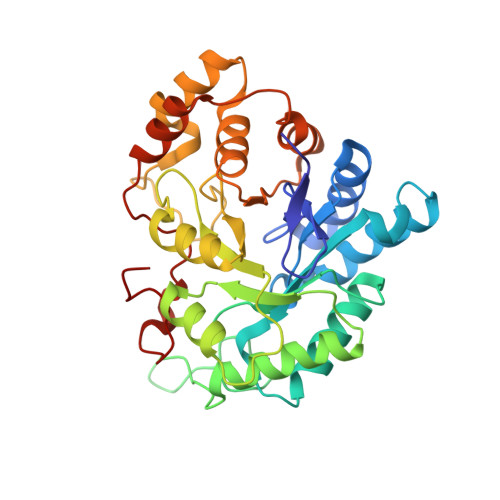Ultrahigh resolution drug design. II. Atomic resolution structures of human aldose reductase holoenzyme complexed with Fidarestat and Minalrestat: implications for the binding of cyclic imide inhibitors
El-Kabbani, O., Darmanin, C., Schneider, T.R., Hazemann, I., Ruiz, F., Oka, M., Joachimiak, A., Schulze-Briese, C., Tomizaki, T., Mitschler, A., Podjarny, A.(2004) Proteins 55: 805-813
- PubMed: 15146479
- DOI: https://doi.org/10.1002/prot.20001
- Primary Citation of Related Structures:
1PWL, 1PWM - PubMed Abstract:
The X-ray structures of human aldose reductase holoenzyme in complex with the inhibitors Fidarestat (SNK-860) and Minalrestat (WAY-509) were determined at atomic resolutions of 0.92 A and 1.1 A, respectively. The hydantoin and succinimide moieties of the inhibitors interacted with the conserved anion-binding site located between the nicotinamide ring of the coenzyme and active site residues Tyr48, His110, and Trp111. Minalrestat's hydrophobic isoquinoline ring was bound in an adjacent pocket lined by residues Trp20, Phe122, and Trp219, with the bromo-fluorobenzyl group inside the "specificity" pocket. The interactions between Minalrestat's bromo-fluorobenzyl group and the enzyme include the stacking against the side-chain of Trp111 as well as hydrogen bonding distances with residues Leu300 and Thr113. The carbamoyl group in Fidarestat formed a hydrogen bond with the main-chain nitrogen atom of Leu300. The atomic resolution refinement allowed the positioning of hydrogen atoms and accurate determination of bond lengths of the inhibitors, coenzyme NADP+ and active-site residue His110. The 1'-position nitrogen atom in the hydantoin and succinimide moieties of Fidarestat and Minalrestat, respectively, form a hydrogen bond with the Nepsilon2 atom of His 110. For Fidarestat, the electron density indicated two possible positions for the H-atom in this bond. Furthermore, both native and anomalous difference maps indicated the replacement of a water molecule linked to His110 by a Cl-ion. These observations suggest a mechanism in which Fidarestat is bound protonated and becomes negatively charged by donating the proton to His110, which may have important implications on drug design.
Organizational Affiliation:
Department of Medicinal Chemistry, Victorian College of Pharmacy, Monash University (Parkville Campus), Parkville, Victoria, Australia.

















